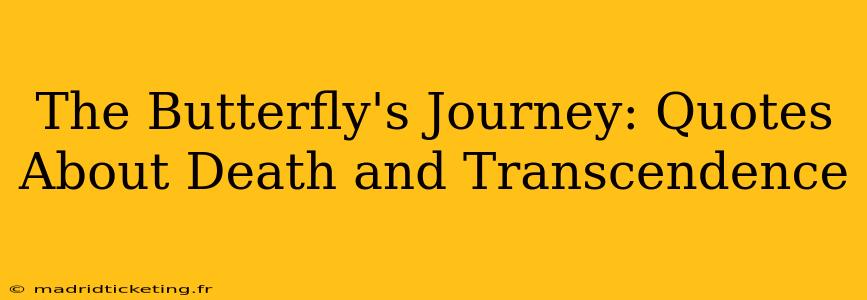The metamorphosis of a butterfly, from crawling caterpillar to soaring winged creature, has long been a potent symbol of death and rebirth, transformation, and transcendence. This powerful imagery has inspired countless writers, poets, and philosophers to explore the mysteries of mortality and the potential for spiritual growth beyond the confines of earthly existence. This exploration delves into the profound connection between butterflies and our understanding of death and what lies beyond, using quotes to illuminate the journey.
What Does a Butterfly Symbolize in Terms of Death and Rebirth?
The butterfly's life cycle—from egg to larva to pupa to imago (adult butterfly)—is a compelling metaphor for the cyclical nature of life and death. The seemingly final stage of the pupa, where the creature appears lifeless, represents a period of transformation, hidden from view. Emerging as a butterfly signifies a radical change, a shedding of the old self to embrace a new, more beautiful existence. This perfectly encapsulates the concept of death as not an ending, but a transition to something beyond our current understanding.
What are Some Famous Quotes About Butterflies and Death?
Many poignant quotes capture the essence of this symbolism. While attributing specific quotes to exact authors can sometimes be challenging due to variations in phrasing and transmission across time, their collective message resonates deeply:
"What the caterpillar calls the end of the world, the master calls a butterfly." This powerful quote, often attributed to Richard Bach (though its exact origin remains debated), elegantly illustrates the contrasting perspectives on death. What appears as an ending to one may be a new beginning for another, a perspective shift that is crucial in grappling with mortality.
"Death is nothing at all. I have only slipped away into the next room. I am I, and you are you, and whatever we were to each other, that we are still." This quote, often attributed to Henry Scott Holland, offers comfort and reassurance, suggesting that death is simply a transition to another state of being, preserving the essence of our relationships and identities. The imagery of slipping into the next room creates a gentle and less fearful image of death.
"The butterfly counts not months but moments, and has time enough." This quote, while not directly referencing death, speaks to the importance of living fully in the present moment. This philosophy often arises in the face of mortality, urging us to cherish every experience and find joy in the fleeting nature of life.
How Do Butterflies Represent Transcendence?
The butterfly’s journey embodies transcendence in several ways:
- Transformation: The drastic change from caterpillar to butterfly symbolizes a profound shift in being, a transcendence of limitations and a move towards a higher state of existence. This resonates with spiritual beliefs about the soul's evolution after death.
- Freedom: The butterfly's ability to fly freely, unburdened by its previous terrestrial existence, represents liberation from earthly constraints. This imagery is often associated with the soul's liberation after death, breaking free from the physical body.
- Beauty: The breathtaking beauty of many butterfly species enhances the symbolism. Their vibrant colors and delicate forms signify the sublime beauty that may lie beyond the veil of death, a realm of exquisite wonder.
What are Other Important Aspects of the Butterfly Metaphor?
Beyond death and rebirth, the butterfly metaphor resonates with other profound concepts:
What does the butterfly symbolize spiritually?
Spiritually, the butterfly often represents the soul, transformation, resurrection, hope, and change. Different cultures hold varying beliefs, but the unifying theme is the butterfly's capacity to represent the transition between earthly and spiritual realms.
What does a butterfly represent emotionally?
Emotionally, the butterfly can evoke feelings of lightness, joy, grace, and freedom. It can also speak to the beauty of impermanence and the acceptance of change, helping to cope with difficult emotions related to loss and transition.
What does the metamorphosis of a butterfly symbolize?
The metamorphosis of a butterfly symbolizes the potential for profound change and growth, even in the face of seeming adversity. It’s a testament to the power of inner transformation and the possibility of a beautiful emergence from even the darkest periods.
The butterfly, therefore, serves as a powerful and enduring symbol, offering solace, hope, and a deeper understanding of the complex and often mysterious journey beyond death. Its vibrant imagery provides a less fearful, more hopeful perspective on life's inevitable end, encouraging us to embrace change and live each moment with appreciation.

